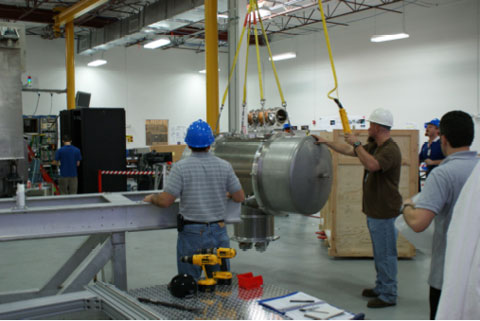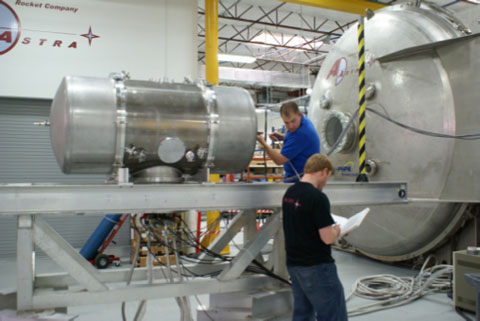|
|

|
 |
| Forum: | Commercial Space - Military Space |
| Topic: | Ad Astra Rocket Company's VASIMR engine |
|
| Want to register?
|
If you have previously registered, but forgotten your password, click here.
| | Robert Pearlman | Ad Astra Rocket Company release NASA and Ad Astra Rocket Company sign agreement for flight test of the VASIMR rocket engine aboard the International Space StationThe National Aeronautics and Space Administration (NASA) and Ad Astra Rocket Company of Webster, Texas have entered into a Space Act Agreement that could lead to conducting a space flight test of the Variable Specific Impulse Magnetoplasma Rocket (VASIMR) engine on the International Space Station (ISS). The VASIMR engine is a new plasma-based space propulsion technology, initially studied by NASA and currently under commercial development by Ad Astra. The agreement was fully executed on December 8, 2008. It was signed on behalf of NASA by its Associate Administrator for Space Operations, William H. Gerstenmaier and on behalf of Ad Astra Rocket Company by its President and Chief Executive Officer, Dr. Franklin R. Chang Diaz. It is the third agreement entered into by the parties since June, 2005 relating to the VASIMR technology development. The agreement is structured in a series of "gates," designed to allow the parties to assess the requirements on an incremental basis while proceeding to flight. Upon the successful achievement of the milestones set forth in the agreement, NASA and Ad Astra envision that VASIMR will be launched to the ISS where the rocket can be tested, for the first time, in its intended environment: the vacuum of outer space. The NASA Authorization Act of 2005, Section 507 (P.L. 109-155) designates the US portion of the ISS a National Laboratory. While smaller projects have already been initiated for installation at interior locations of the ISS, the Ad Astra project will serve as a "pathfinder" by demonstrating a new class of larger, more complex externally-installed science and technology payloads, encouraging others to pursue similar projects and facilitating their efforts with a model for implementation. The primary technical objective of the project is to operate the VASIMR VF-200 engine at power levels up to 200 kW. Engine operation will be restricted to pulses of up to 10 minutes at this power level. Energy for these high-power operations will be provided by a battery system trickle-charged by the ISS power system. These tests will mark the first time that a high-power, steady-state electric thruster will be used as part of a manned spacecraft. Ad Astra is developing the VF-200 payload entirely with funds from private investors. The partnership described in this agreement represents a collaboration between NASA and a private entity never before attempted. Ad Astra is excited to partner with NASA on the goals set forth in this innovative partnership which, when successfully accomplished, will dramatically demonstrate the use, versatility and value of the ISS as a national asset. | | Robert Pearlman | NASA release NASA Administrator Hails Agreement with Ad AstraNASA and Ad Astra Rocket Company of Webster, Texas, have signed a Space Act Agreement that could lead to the testing of a new plasma-based space propulsion technology on the International Space Station. The Variable Specific Impulse Magnetoplasma Rocket (VASIMR) engine initially was studied by NASA and is being commercially developed by Ad Astra. This is the first such agreement for a payload on the station’s exterior and represents an expansion of NASA’s plans to operate the U.S. portion of the space station as a national laboratory. This effort follows the success achieved by the agency last year in reaching multiple agreements to utilize internal station sites for this endeavor. "Ad Astra's Space Act Agreement with NASA offers an example of just the kind of research and technology development that we should be doing on the International Space Station, can do there, and cannot easily do anywhere else," NASA Administrator Michael Griffin said. "Dr. Chang-Diaz's VASIMR engine concept has long held great theoretical promise for future high-efficiency space propulsion. With this agreement, we are taking the first steps down the road to its practical realization. I am grateful to the teams on both sides who have worked to develop a plan that yields a near-term step forward for both Ad Astra and NASA on this exciting prospect." NASA's Associate Administrator for Space Operations William Gerstenmaier and Ad Astra's President and Chief Executive Officer Franklin Chang Diaz signed the agreement on Dec. 8. The agreement is structured in a series of "gates," designed to allow the parties to assess milestones on an incremental basis while proceeding to flight. Upon the achievement of these milestones, NASA and Ad Astra envision that VASIMR will be launched to the station and be tested, for the first time, in the vacuum of space. The VASIMR project will pave the way in demonstrating a new class of larger, more complex science and technology payloads to be installed on the station's exterior. Smaller projects already have been started for installation inside the station as part of the effort to use the U.S. portion of the station as a national laboratory. NASA hopes the agreement with Ad Astra will encourage other entities, governmental and commercial, to pursue similar projects and to facilitate the success of those projects by providing a model for implementation. Chang-Diaz, a former astronaut and veteran of seven space shuttle flights is a plasma physicist. In 2001, the American Institute of Aeronautics and Astronautics awarded him the Wyld Propulsion Award for his 21 years of research on the VASIMR engine. | | Robert Pearlman | Ad Astra release VASIMR VX-200 superconducting magnet delivered to Houston facility and passes all acceptance testsThe VX-200 low temperature superconducting magnet has been delivered to Ad Astra's Houston facility by its manufacturer, Scientific Magnetics Ltd. of Oxford, England and has successfully passed a battery of acceptance tests conducted by a combined team from Scientific Magnetics and Ad Astra. The superconductor is an essential component of the VASIMR(TM) engine and is responsible for generating the strong magnetic field required to fully heat and accelerate the plasma in the engine.  Above: VX-200 Superconducting magnet arrival and installation at Ad Astra's Houston facility. Short for Variable Specific Impulse Magnetoplasma Rocket, VASIMR(TM) is a new high-power plasma-based space propulsion technology, initially studied by NASA and now being developed privately by Ad Astra. A VASIMR(TM) engine could maneuver payloads in space far more efficiently and with much less propellant than today's chemical rockets. Ultimately, VASIMR(TM) engines could also greatly shorten robotic and human transit times for missions to Mars and beyond. The new magnet arrived at Ad Astra's Houston facility on February 10 and was unpacked by Scientific Magnetics personnel with assistance of the Ad Astra technical team. The system subsequently underwent two complete one-week thermal and magnetic cycles from room temperature to cryogenic conditions inside its own vacuum jacket. At its nominal operating temperature of 5 oK (-268 oC), the magnet was energized to its full field capability of 2 tesla (maximum on axis). The field was measured and compared with predicted values. The difference between measurement and prediction was found to be well within acceptable margins (less than 0.3%). While these tests were ongoing, the VX-200i, an "interim" version of the VX-200 (hence the appended "i" in VX-200i), operating with a less powerful water-cooled magnet continued as scheduled, exercising the new control algorithms enabling the combined operation of its first and second plasma stages. The VX-200i was developed in-house by Ad Astra to minimize potential impacts to the VX-200 schedule brought about by the delayed delivery of the superconducting module by Scientific Magnetics. The in-house development of an interim magnet with the same structural "footprint" as the superconductor, allowed testing of other VX-200 subsystems to proceed.  Above: VX-200 Superconducting magnet is installed in test frame and undergoes magnetic field measurements. Based upon the superconductor test results, the new magnet has been accepted by Ad Astra and is now ready to replace the interim magnet and allow the VX-200 to operate at its design capability. Integration of the new magnet is scheduled to begin in mid-March following completion of the last few programmed tests on the VX-200i. The successful achievement of this milestone is the last step in the full integration of the VASIMR(TM) VX-200 prototype and clears the way for full power tests to proceed through mid- May. The completion of these tests will yield the required data set for the design of the VF-200 flight engine. | | SpaceAholic | From Ars Technica: As part of a program to develop the next generation of in-space propulsion systems, NASA awarded Chang-Díaz's company, Ad Astra, a three-year, $9 million contract in 2015. This unlocked an opportunity long awaited — a chance to prove the doubters wrong. Naturally, it won't be easy. Ad Astra must fire its plasma rocket for 100 hours, at a power level of 100 kilowatts, next year.This February, the company has worked about halfway through that contract, and Ars has been keeping tabs on progress in the lab. So far, the immigrant from Costa Rica seems to be holding up his end of the bargain. NASA gave the company a sterling review after the first year of the agreement. Still, there is a ways to go. During a visit this month, the VASIMR engine fired at 100kW for 10 seconds and 50kW for one minute. | |



